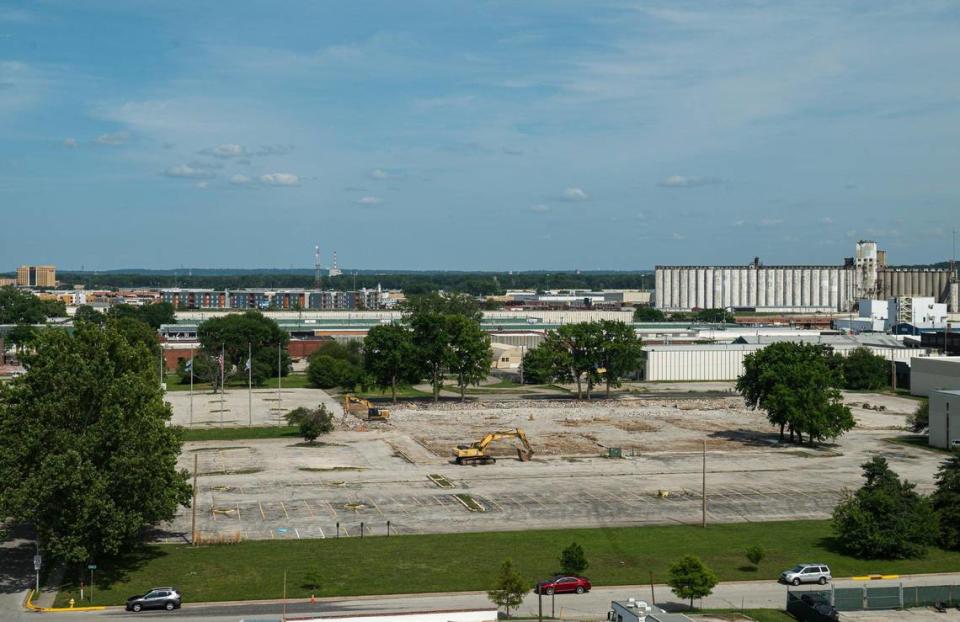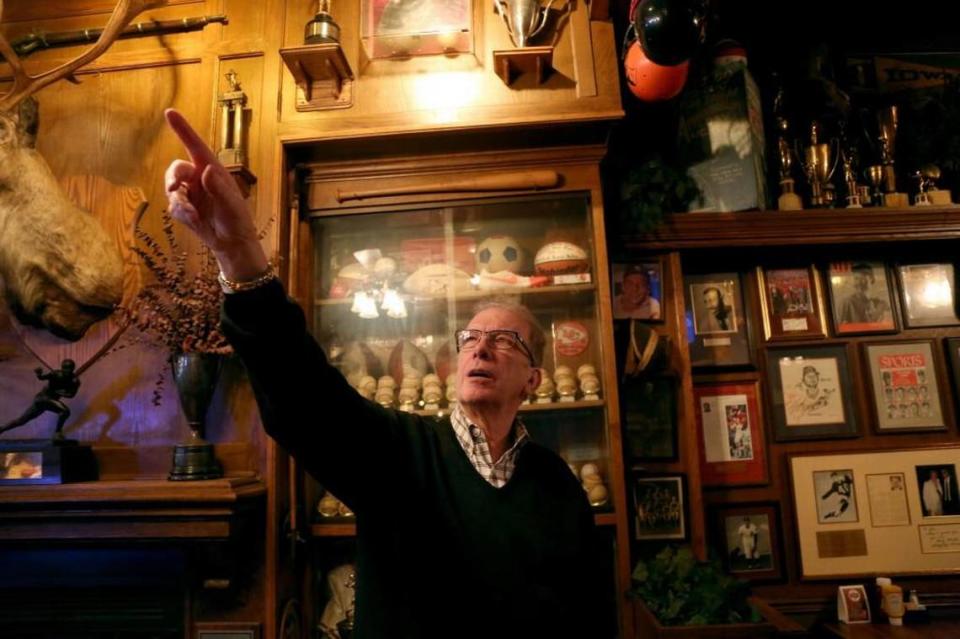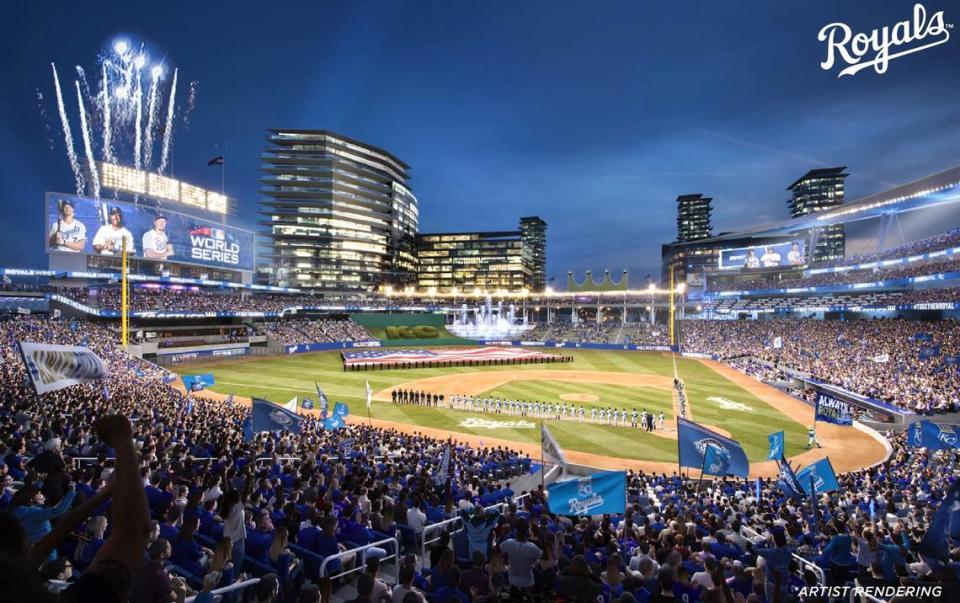‘We want it more’: Inside North Kansas City’s hard sell to land the new Royals stadium
A Royals fan since the team’s inception in 1969, Jim Chappell was all in on the team moving to downtown Kansas City.
He’s seen stadiums thrive in the urban cores of other cities. And he thinks the same is possible here. Not just a stadium but an entirely new district. Like another Westport or Plaza, he said.
“I was 100% for it moving downtown,” he said.
But not anymore: “Now I’m 0%.”
That’s because Chappell, the founder of North Kansas City’s iconic Chappell’s Restaurant & Sports Museum, is now one of the most vocal advocates of luring the Royals north of the Missouri River — a possibility with the Major League Baseball team narrowing its stadium search to two sites.
For some time, the Royals have studied building their new stadium in downtown’s East Village, a mostly vacant neighborhood near Kansas City Hall. But team leaders say North Kansas City is also a viable site for their new $1 billion stadium surrounded by a $1 billion ballpark district.
Sources told The Star that talks with Jackson and Clay counties have progressed to the financial terms of a potential stadium deal. In a letter to the public Tuesday, Royals majority owner John Sherman said the team would announce its preferred location by the end of September.
Many north of the river acknowledge their quest is somewhat of a longshot.
After all, the downtown site is close to other amenities like the Power & Light District, the T-Mobile Center, the Kansas City Streetcar and thousands of existing hotel rooms and parking spaces.
Still, Clay County officials think they have a strong case for the Royals.
The biggest selling point: space.
In North Kansas City, the Royals would have access to nearly 100 acres of land owned or controlled by the influential Merriman family. It’s more than quadruple the size of the 20 or so acres in the East Village, which have been assembled by VanTrust Real Estate in recent years.

No stadium needs 100 acres. But the distinction matters when considering the Royals’ plans to build a vibrant district surrounding the ballpark that could add new restaurants, hotels and apartments. More land also makes adding parking, especially surface parking lots, much easier.
Some see the stadium as a chance for the Royals to tap into the expanding economy of Clay County, one of the fastest growing counties in Missouri. And the North Kansas City site also offers quick access to interstates 35 and 29 as well as U.S. 169 and Missouri 9.
Just as important: The politics in Clay County appear easier.
While some politicians in Kansas City and Jackson County have grown exasperated with the baseball club in recent months, the story is different on the other side of the river where politicians are aggressively courting the stadium project.
“We want it more,” Chappell said.
North Kansas City city is changing
When Adam Roberts took over the Screenland Armour Theatre more than a decade ago, North Kansas City was a different place.
It was before Chicken N Pickle, before the breweries and distilleries.
That’s mostly changed with new apartments, hotels and more coming into the city. A former city council member, Roberts said City Hall has quietly laid the groundwork for major redevelopment. They’ve added bike lanes and are studying a river crossing to bring the Kansas City Streetcar to Clay County.
“There’s a lot of cool things that have been gradually piecing together,” he said.
He thinks the Royals would find a more authentic vibe in North Kansas City. Young people today are more interested in independent local businesses, he said, rather than glitzy destinations like Power & Light.
“It does feel small and quaint,” he said of the city with a population of 4,500, “but once you get into Armour Road it’s cool because you’re in this weird old downtown that doesn’t feel like other parts of Kansas City.”
Chappell’s restaurant, which he sold five years ago but is still at nearly every day, is a mainstay on the downtown strip — packed with thousands of jerseys, photos and helmets. There’s old Kansas City Athletics gear, a framed 1984 Sports Illustrated featuring George Brett, rookie baseball cards and stadium photos back to the days of Municipal Stadium.
And while he wants to see the team he loves make their home nearby, he believes that North Kansas City still wins, even if the Royals don’t build there.
That’s because the massive land assembled for a potential site portends major changes for the city.
The wealthy Merriman family, which runs companies like Americo Life Inc., recently partnered with another developer to open the nine-story, $50 million Oxbow apartments on East 18th Avenue in North Kansas City.
Locals expect the family to continue with such developments, particularly in the industrial tracts south of Armour Road.
Currently, most people live north of Armour Road, while most of the territory south is filled with warehouses, factories and small offices. Even without a stadium, major redevelopment there could bring in thousands of new residents and new amenities.
“We still get that. We can’t lose,” Chappell said.

Scott Wagner, a commissioner for the western portion of Clay County, said it’s hard to ignore the momentum of North Kansas City.
“People have noticed the growth in North Kansas City over the past several years,” he said. “You have people who are interested in moving into this area, you have people who are opening their businesses in the area.”
Bungalows in The Avenues, the neighborhoods north of Armour Road, often are sold before they’re even listed. The city sits in the popular North Kansas City school district, features a walkable downtown and is just a quick drive to other parts of the metro.
“North Kansas City has been changing for a long time now with new development,” said Anthony Saper, a city councilman whose ward includes part of the potential baseball site.
So far, Saper hasn’t made up his mind on the stadium — just like many of his constituents.
“They’re very mixed because of the uncertainty of what it would mean and how it would be done,” he said. “And there’s been no real information on that. It’s sort of a black box at this point.”
Richard Groves, executive director of the North Kansas City Business Council, said a stadium likely would displace some of the businesses in the area, but it also would offer new economic opportunities for local businesses.
“It’s kind of a mixed bag,” he said of the current climate surrounding the stadium discussion.
‘A serious contender’
Sherman has made it clear that a North Kansas City stadium would look and feel different than one in the downtown loop.
The smaller site in downtown would feature denser developments and taller buildings surrounding the stadium. In North Kansas City, Sherman said the project would have similar features but be more horizontal in nature.
Sherman told reporters in late July that backers of the Clay County site were “highly motivated” and “very creative.” A ballpark there, he said, could help connect the Northland to other parts of the metro.
“It’s really a way to expand how you think about downtown,” he said.
Chappell said a North Kansas City ballpark could help bridge the north-south divide that has persisted in Kansas City for decades.
“It would make that river a lot less wide,” he said.
Still, Sherman said the team has studied the downtown site the most. He noted that the team has leased its stadium from Jackson County for more than 50 years.

Sherman has indicated the team will seek to extend the current ⅜-cent sales tax that has funded both Kauffman and Arrowhead stadiums in Jackson County — if they choose to pursue a stadium in downtown Kansas City. In Clay County, the team would likely push for a 1-cent, 40-year sales tax to help fund the new stadium.
Jerry Nolte, Clay County presiding commissioner, said the county could put something on a ballot as soon as November, though that seems unlikely now. While he said talks are progressing, he wouldn’t share specifics.
But Clay County leaders like their chances.
“Four or five months ago, I think everybody would have thought we were getting played to leverage Jackson County,” said Jason Withington, a Western at-large Clay County Commissioner.
Now, he says that has changed.
“We’ve had meetings with the Royals ownership and Clay County is a serious contender,” Withington said.
He thinks the sheer size of the North Kansas City site is the clearest draw for the Royals and developers wanting to build out the ballpark district. He expects the state would work to revamp interstate on and off ramps for easier access to the stadium.
“I honestly believe if the Royals build in the East Village they’re going to have regret and they’re going to wish they were in North Kansas City,” he said.
The Star’s Sam McDowell contributed to this report.

